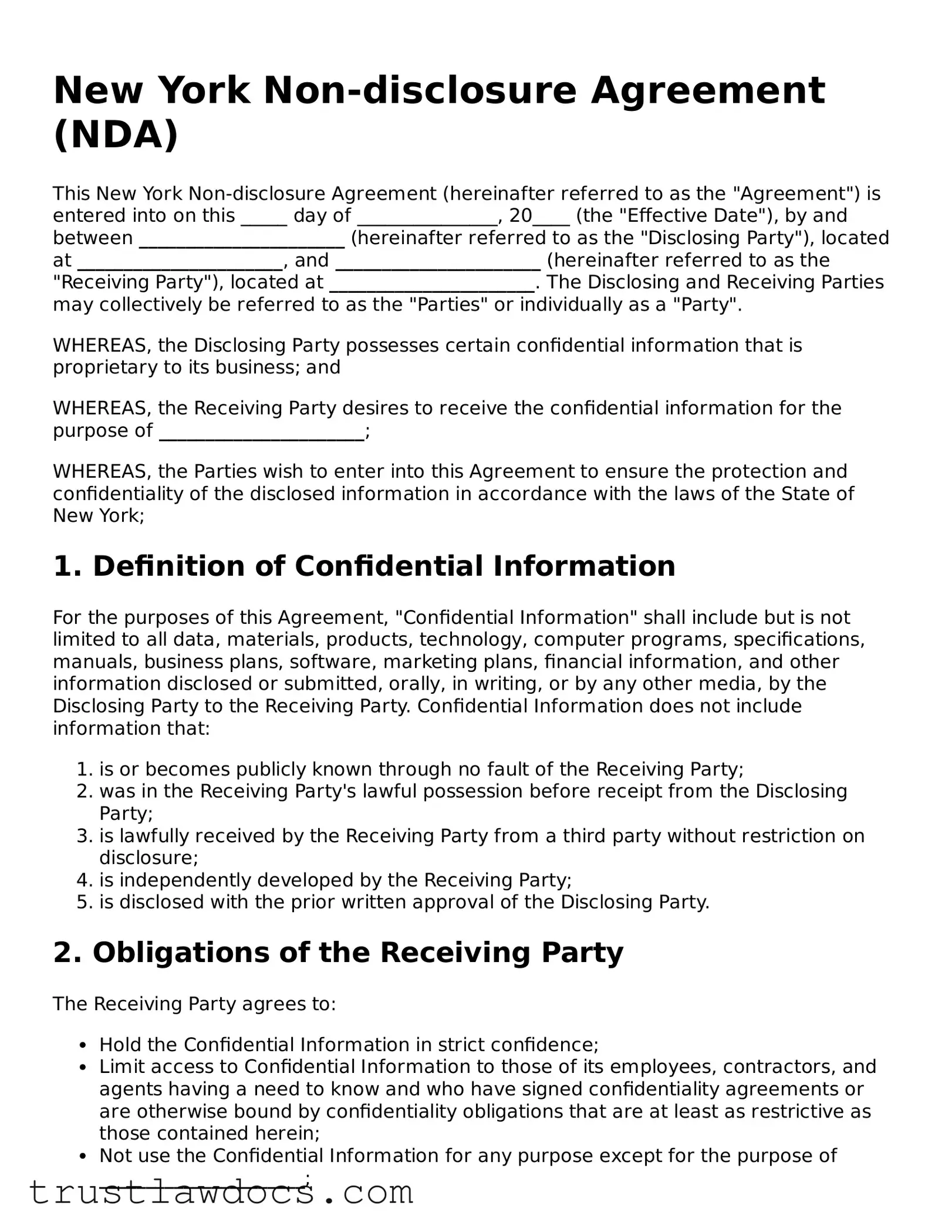New York Non-disclosure Agreement (NDA)
This New York Non-disclosure Agreement (hereinafter referred to as the "Agreement") is entered into on this _____ day of _______________, 20____ (the "Effective Date"), by and between ______________________ (hereinafter referred to as the "Disclosing Party"), located at ______________________, and ______________________ (hereinafter referred to as the "Receiving Party"), located at ______________________. The Disclosing and Receiving Parties may collectively be referred to as the "Parties" or individually as a "Party".
WHEREAS, the Disclosing Party possesses certain confidential information that is proprietary to its business; and
WHEREAS, the Receiving Party desires to receive the confidential information for the purpose of ______________________;
WHEREAS, the Parties wish to enter into this Agreement to ensure the protection and confidentiality of the disclosed information in accordance with the laws of the State of New York;
1. Definition of Confidential Information
For the purposes of this Agreement, "Confidential Information" shall include but is not limited to all data, materials, products, technology, computer programs, specifications, manuals, business plans, software, marketing plans, financial information, and other information disclosed or submitted, orally, in writing, or by any other media, by the Disclosing Party to the Receiving Party. Confidential Information does not include information that:
- is or becomes publicly known through no fault of the Receiving Party;
- was in the Receiving Party's lawful possession before receipt from the Disclosing Party;
- is lawfully received by the Receiving Party from a third party without restriction on disclosure;
- is independently developed by the Receiving Party;
- is disclosed with the prior written approval of the Disclosing Party.
2. Obligations of the Receiving Party
The Receiving Party agrees to:
- Hold the Confidential Information in strict confidence;
- Limit access to Confidential Information to those of its employees, contractors, and agents having a need to know and who have signed confidentiality agreements or are otherwise bound by confidentiality obligations that are at least as restrictive as those contained herein;
- Not use the Confidential Information for any purpose except for the purpose of ______________________;
- Not disclose the Confidential Information to any third party without the prior written consent of the Disclosing Party.
3. Time Period
The confidentiality obligations of the Receiving Party shall commence on the Effective Date of this Agreement and shall continue for a period of ______________________ years thereafter.
4. Return of Confidential Information
Upon the termination of this Agreement, or upon the Disclosing Party's written request, the Receiving Party shall promptly return or destroy all copies of the Confidential Information received under this Agreement, and certify in writing to the Disclosing Party that it has done so, unless otherwise directed by the Disclosing Party.
5. No License
Nothing in this Agreement shall be construed as granting any rights under any patent, trademark, copyright, or other intellectual property rights of the Disclosing Party, except the rights expressly granted herein.
6. Governing Law
This Agreement shall be governed by and construed in accordance with the laws of the State of New York, without giving effect to any choice or conflict of law provision or rule.
7. Entire Agreement
This Agreement constitutes the entire agreement between the Parties concerning the subject matter hereof and supersedes all prior agreements, understandings, negotiations, and discussions, whether oral or written, between the Parties.
8. Amendment
No amendment, modification, or supplement of any provisions of this Agreement shall be valid or effective unless made in writing and signed by both Parties.
9. Waiver
No waiver by any Party of any default, misrepresentation, or breach of warranty or covenant hereunder, whether intentional or not, shall be deemed to extend to any prior or subsequent default, misrepresentation, or breach of warranty or covenant hereunder or affect in any way any rights arising by virtue of any prior or subsequent such occurrence.
IN WITNESS WHEREOF, the Parties hereto have executed this New York Non-disclosure Agreement as of the Effective Date first above written.
Disclosing Party:
Name: ________________________________
Signature: _____________________________
Date: ____________________________________
Receiving Party:
Name: ________________________________
Signature: _____________________________
Date: ____________________________________
